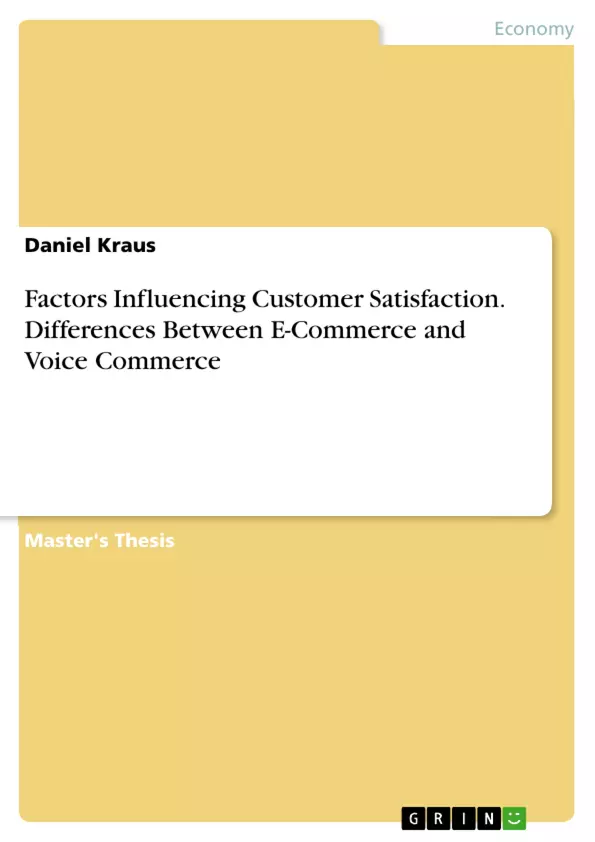This thesis comparatively investigates factors for customers satisfaction in voice commerce and e-commerce to assess the emphasis customers place on factors in both channels. Voice commerce is a newly evolving electronic commerce channel where customers communicate with dedicated systems on smart speakers, mobile phones or other devices using their voice, in order to find and order products.
This thesis identifies customer satisfaction predictors that potentially differ between both channels: convenience and transaction process efficiency are based on previous research on chatbot and digital assistant expectations. In the area of recommendations, recommendation personalization (the degree of personalization of product recommendations) is identified from previous research. The construct of recommendation complexity has been created, which is the degree of detail and amount of information recommendations are presented. Differences in this domain of computer-human-interaction are explained by media richness theory, an application of neuro-ergonomics.
Data was collected through a survey conducted on the crowdsourcing platform Amazon MTurk. The sample consisted of 178 US consumers that had purchased goods using both e-commerce and voice commerce. Structural equation modeling (SEM) was used as well as multiple regression analysis for statistical hypotheses testing. Two SEM models were created for each voice commerce and e-commerce and both models were compared to investigate comparative hypotheses.
This research enables product managers to recognize which factors of customers satisfaction differ from those in e-commerce. While developing their voice commerce strategy and system design, managers should emphasize convenience factors such as ease of use and ease of understanding, as well as an efficient transaction process.
Inhaltsverzeichnis (Table of Contents)
- Introduction
- Background
- Outline and Scope
- Literature Review and Hypotheses Development
- Overview
- Voice Commerce
- Brief History of the Conversational Interface
- Differences in Electronic Commerce Channels
- Comparison Framework
- Technology Dimension
- Value Dimension
- Media Richness
- Voice Unimodality
- Speech Input
- Speech Output
- Customer Satisfaction Factors
- Recommendation Complexity
- Recommendation Personalization
- Convenience
- Transaction Process Efficiency
- Research Methodology
- Study Design and Measurement Scales
- Data Collection
- Acquisition using MTurk
- Screening Survey
- Main Survey
- Quality Control
- Respondent Characteristics
- Age and Gender
- IT Affinity
- Usage Frequency and Technologies
- Data Analysis
- Sample Size Considerations
- Descriptive Statistics
- Reliability
- Principal Component Analysis
- Structural Equation Modeling
- Measurement Models
- Structural Models
- Empirical Findings
- Moderation
- Multiple Regression Analysis
- Considerations and Recommendations
- Discussion
- Implications for Practice
- Implications for Research
- Limitations and Design Issues
- Directions for Future Research
Zielsetzung und Themenschwerpunkte (Objectives and Key Themes)
This thesis aims to compare factors influencing customer satisfaction in voice commerce and e-commerce to understand the emphasis customers place on specific factors in each channel. The research seeks to identify differences in customer expectations for convenience, transaction process efficiency, recommendation personalization, and recommendation complexity between the two channels.
- Customer satisfaction in voice commerce and e-commerce
- Differences in customer expectations across various factors
- Convenience and transaction process efficiency in both channels
- Recommendation personalization and complexity in voice commerce and e-commerce
- Media richness theory and its application to voice commerce
Zusammenfassung der Kapitel (Chapter Summaries)
- Introduction: This chapter sets the stage for the research, outlining the background of voice commerce, the scope of the study, and the overall structure of the thesis.
- Literature Review and Hypotheses Development: This chapter delves into the existing literature on voice commerce, conversational interfaces, and customer satisfaction factors in both e-commerce and voice commerce. It identifies key differences between the two channels and establishes the hypotheses for the study.
- Research Methodology: This chapter describes the research design and data collection methods employed in the study. It outlines the survey design, participant recruitment using Amazon Mechanical Turk, and the screening and quality control measures taken. It also provides details on the respondent characteristics.
- Data Analysis: This chapter presents the results of the data analysis, including sample size considerations, descriptive statistics, reliability analysis, principal component analysis, and structural equation modeling. It also examines the effects of moderation and presents findings from multiple regression analysis.
- Considerations and Recommendations: This chapter discusses the findings of the research, highlighting implications for practice and research. It explores the limitations of the study and provides recommendations for future research.
Schlüsselwörter (Keywords)
This research focuses on the key concepts of voice commerce, e-commerce, customer satisfaction, chatbots, recommender systems, media richness, convenience, transaction process efficiency, recommendation personalization, and recommendation complexity. The study aims to understand how these concepts influence customer satisfaction and expectations across different commerce channels.
- Arbeit zitieren
- Daniel Kraus (Autor:in), 2018, Factors Influencing Customer Satisfaction. Differences Between E-Commerce and Voice Commerce, München, GRIN Verlag, https://www.grin.com/document/463605



